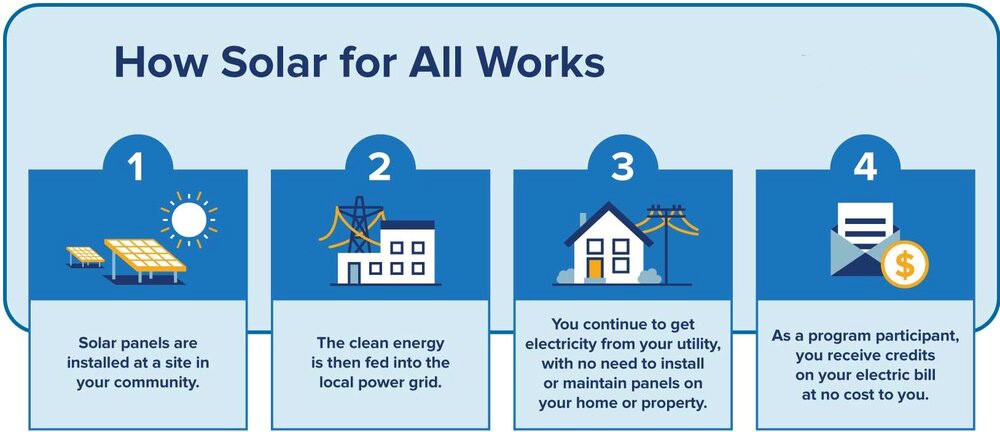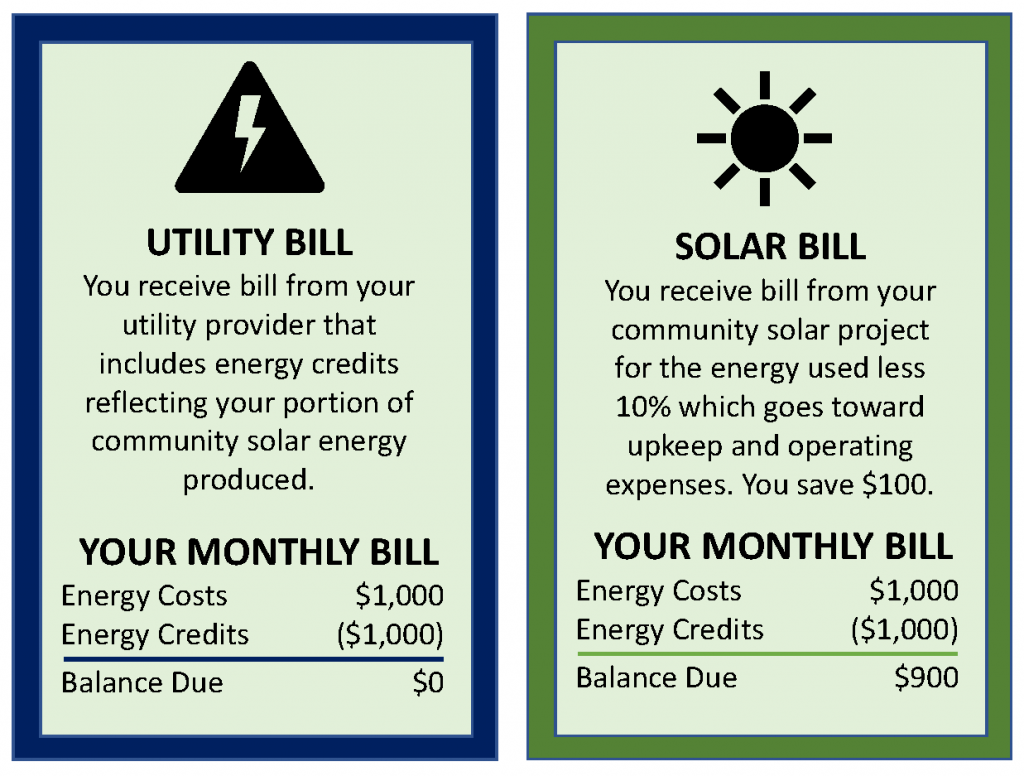5 Benefits of Offsite Community Solar for Businesses

What is Offsite Community Solar?
Community solar is an offsite model that is increasing its presence across the U.S. and quickly growing in popularity. It provides a group solution that allows individuals, businesses and other organizations to take advantage of renewable solar-powered electricity without the burden of installing an array of panels and equipment on their own property.
Also called “shared solar” or “solar gardens,” these projects deliver an excellent offsite community solar solution for those who don’t have adequate space or sunshine for their own installation or don’t own their property or roof. It gives businesses the added advantage of avoiding upfront capital expenditure.
According to the U.S. Office of Energy Efficiency and Renewable Energy, about a third of the states have legislation and enabling policies to establish a third-party market for community solar. Project developers and larger, investor-owned utilities must follow certain regulations to develop community solar installations and enroll customers. Outside those states, community solar programs are developed and managed by the local utilities that are typically smaller municipal or cooperative utilities.
How Does Offsite Community Solar Work?
The solar array is constructed at an off-site location that is optimal for project size and plenty of sunshine. Common locations include capped landfills, unused farm land and large rooftops. The solar project is usually owned by a group of investors or a single entity such as a township or solar company. Output is usually less than 5 megawatts of electrical capacity.

Graphic credit: Smart Energy Choices CNY
To participate in community solar, you must have an account with an electricity utility. You then purchase or subscribe to the community solar project for a defined portion of its power generation. The project’s solar electricity feeds into the regional power grid, and the grid delivers the power to your facilities. For that reason, the community solar project must be in the same electricity service area as determined by the utilities and transmission providers.
There are two different types of community solar memberships. Project developers decide what kind of plans they want to offer members.
- Most members choose a subscription plan with little or no initial fees and shorter term options that give them flexibility.
- The other choice is a purchase plan in which you take ownership of one or more panels at the solar project site. With ownership, there can be greater potential for savings over time and a choice of financing options. Your business may also qualify for federal tax credits.
The electricity is delivered by your utility provider, so you continue to have the same utility relationship and services. If, for some reason, the community solar project temporarily stops producing power, you still receive power and service from your utility.
Finding the Savings
When you subscribe to the community solar project, you share in the resulting solar electricity production that reduces the price of the electricity generated. The utility delivers the electricity to your facilities, usually at a 10% discount from what your utility would have charged you. Many states simply credit your bill for the supply portion of your fees. The solar provider then bills you less 10% of those supply fees for the solar production. This process occasionally occurs through virtual net metering, also called “shared renewables.” Your share of credits is proportional to the size of your subscription or ownership.
Not all states support virtual net metering, but in those that do, most solar subscribers receive their usual bill from their utility provider. The bill displays energy credits for your share of the power produced by your community solar project. You then share those credits with the solar project, and the credits are deducted from your solar project bill.
In most states, you will receive two bills: one from the community solar project and another from the utility. Some states are trying to narrow it down to a single bill. Because each state has its own approach to community solar, businesses with locations in more than one state need to be knowledgeable about each state’s regulations when choosing their solar providers.
5 Reasons Why Offsite Community Solar is Good for Your Business
1. No upfront investment: Since the solar installation is on someone else’s property, you avoid the upfront costs of installing and maintaining your own solar generation panels and equipment. You skip the headaches of permitting and construction, too. The subscription option allow you to “pay as you go.” You gain all the advantages of solar energy, with none of the pains, and you can start using renewable energy right away.
2. Sustainability: When you use solar energy, you use fewer fossil fuels and reduce your carbon footprint. This is increasingly important to your customers, shareholders and employees. Locally produced, affordable clean energy has a positive ripple effect on your community’s economy, environment and wellbeing. People want to do business with a company that is doing its part to protect the planet, and it helps you attract and retain talented employees.
3. Guaranteed Savings: You can offset your business’ electricity bill with predictable rates and terms–without any disruption to your business. Solar energy is often cheaper than traditionally generated electricity. You earn energy credits that lower your costs for electricity, usually by 10%. When your energy spend is large, that can add up to big savings. This frees up cash flow and lets you invest in other corporate initiatives.
4. Portability: If you need to expand and relocate your facilities, you can maintain the same power arrangement as long as you stay within the same utility service area. Because you receive your electricity through your local utility, you have a reliable flow of electricity, even when the sun isn’t shining.
5. Easy In/Easy Out: Once you identify the project that best suits your needs, signing up is easy. You can often enjoy the benefits of renewable electricity within a month. If you decide you no longer want to participate in the community solar project, you can usually opt out with no penalty by giving adequate notice.
The SEIA (Solar Energy Industries Association) claims that 2,826 megawatts of community solar have been installed in the U.S. through 2020. Forty states have at least one community solar project online, and 19 states (plus Washington, DC) have established policies and programs encouraging growth. The SEIA expects community solar to add 3.5 gigawatts to the grid over the next five years. This increases the breadth, resilience and reliability of our power supply across the U.S.
The energy experts at Cost Control Associates are well-versed in offsite community solar and can help you navigate the options, policies and regulations wherever you conduct business. We’ve been helping businesses save money on energy for 30 years and are independent of any suppliers or installers. Contact us to learn more about how we can help your business pay less.
